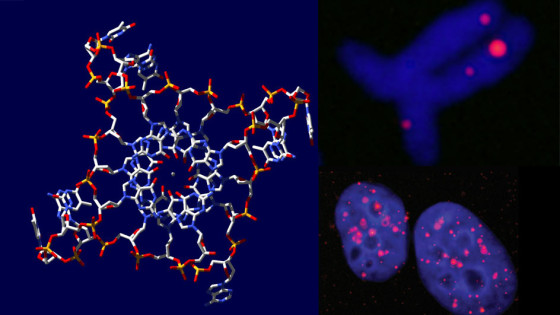Four-stranded ‘quadruple helix’ DNA structure proven to exist in human cells
January 22, 2013

Researchers have shown that four-stranded quadruple helix DNA structures — known as G-quadruplexes — exist within the human genome. (Credit: Jean-Paul Rodriguez and Giulia Biffi)
Cambridge University researchers have published a paper that they say proves that four-stranded “quadruple helix” DNA structures (G-quadruplexes) exist within the human genome.
They form in regions of DNA that are rich in the DNA building block guanine (G).
The findings mark the culmination of over 10 years investigation by scientists to show these complex structures in vivo (in living human cells) using computational modelling, synthetic lab experiments, and fluorescent biomarkers to identify human cancer cells.
The research shows clear links between concentrations of four-stranded quadruplexes and the process of DNA replication, which is pivotal to cell division and production.
Some scientists believe it may be possible to halt the runaway cell proliferation at the root of cancer, targeting quadruplexes with synthetic molecules that trap and contain these DNA structures and thus preventing cells from replicating their DNA, and consequently blocking cell division.
“We are seeing links between trapping the quadruplexes with molecules and the ability to stop cells dividing, which is hugely exciting,” said Professor Shankar Balasubramanian from the University of Cambridge’s Department of Chemistry and Cambridge Research Institute, whose group produced the research.
“The research indicates that quadruplexes are more likely to occur in genes of cells that are rapidly dividing, such as cancer cells. For us, it strongly supports a new paradigm to be investigated — using these four-stranded structures as targets for personalized treatments in the future.”
Physical studies over the last couple of decades had shown that quadruplex DNA can form in vitro (in the lab), but the structure was considered to be a curiosity rather than a feature found in nature. The researchers now know for the first time that they actually form in the DNA of human cells.
The study published today was led by Giulia Biffi, a researcher in Balasubramaninan’s lab at the Cambridge Research Institute.
By building on previous research, Biffi was able to generate antibody proteins that detect and bind to areas in a human genome rich in quadruplex-structured DNA, proving their existence in living human cells.
Using fluorescence to mark the antibodies, the researchers could then identify hot spots for the occurrence of four-stranded DNA — both where in the genome and, critically, at what stage of cell division.
While quadruplex DNA is found fairly consistently throughout the genome of human cells and their division cycles, a marked increase was shown when the fluorescent staining grew more intense during the s-phase — the point in a cell cycle where DNA replicates before the cell divides.
Cancers are usually driven by genes called oncogenes that have mutated to increase DNA replication — causing cell proliferation to spiral out of control, and leading to tumor growth.
The increased DNA replication rate in oncogenes leads to an intensity in the quadruplex structures. This means that potentially damaging cellular activity can be targeted with synthetic molecules or other forms of treatments.